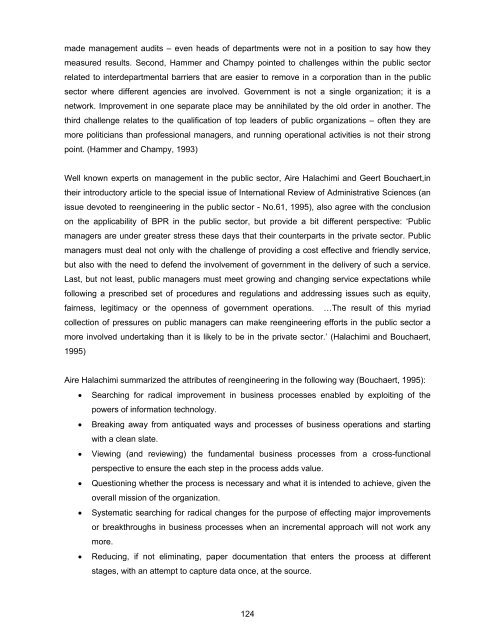Organizational Development: A Manual for Managers and ... - FPDL
Organizational Development: A Manual for Managers and ... - FPDL
Organizational Development: A Manual for Managers and ... - FPDL
Create successful ePaper yourself
Turn your PDF publications into a flip-book with our unique Google optimized e-Paper software.
made management audits – even heads of departments were not in a position to say how they<br />
measured results. Second, Hammer <strong>and</strong> Champy pointed to challenges within the public sector<br />
related to interdepartmental barriers that are easier to remove in a corporation than in the public<br />
sector where different agencies are involved. Government is not a single organization; it is a<br />
network. Improvement in one separate place may be annihilated by the old order in another. The<br />
third challenge relates to the qualification of top leaders of public organizations – often they are<br />
more politicians than professional managers, <strong>and</strong> running operational activities is not their strong<br />
point. (Hammer <strong>and</strong> Champy, 1993)<br />
Well known experts on management in the public sector, Aire Halachimi <strong>and</strong> Geert Bouchaert,in<br />
their introductory article to the special issue of International Review of Administrative Sciences (an<br />
issue devoted to reengineering in the public sector - No.61, 1995), also agree with the conclusion<br />
on the applicability of BPR in the public sector, but provide a bit different perspective: ‘Public<br />
managers are under greater stress these days that their counterparts in the private sector. Public<br />
managers must deal not only with the challenge of providing a cost effective <strong>and</strong> friendly service,<br />
but also with the need to defend the involvement of government in the delivery of such a service.<br />
Last, but not least, public managers must meet growing <strong>and</strong> changing service expectations while<br />
following a prescribed set of procedures <strong>and</strong> regulations <strong>and</strong> addressing issues such as equity,<br />
fairness, legitimacy or the openness of government operations. …The result of this myriad<br />
collection of pressures on public managers can make reengineering ef<strong>for</strong>ts in the public sector a<br />
more involved undertaking than it is likely to be in the private sector.’ (Halachimi <strong>and</strong> Bouchaert,<br />
1995)<br />
Aire Halachimi summarized the attributes of reengineering in the following way (Bouchaert, 1995):<br />
• Searching <strong>for</strong> radical improvement in business processes enabled by exploiting of the<br />
powers of in<strong>for</strong>mation technology.<br />
• Breaking away from antiquated ways <strong>and</strong> processes of business operations <strong>and</strong> starting<br />
with a clean slate.<br />
• Viewing (<strong>and</strong> reviewing) the fundamental business processes from a cross-functional<br />
perspective to ensure the each step in the process adds value.<br />
• Questioning whether the process is necessary <strong>and</strong> what it is intended to achieve, given the<br />
overall mission of the organization.<br />
• Systematic searching <strong>for</strong> radical changes <strong>for</strong> the purpose of effecting major improvements<br />
or breakthroughs in business processes when an incremental approach will not work any<br />
more.<br />
• Reducing, if not eliminating, paper documentation that enters the process at different<br />
stages, with an attempt to capture data once, at the source.<br />
124
















